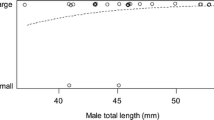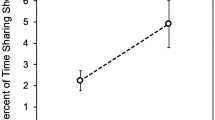Synopsis
We examined how spatial distribution and the use of aggressive behavior by blue gouramis, Trichogaster trichopterus (Belontiidae), in the presence of a concentrated food source were affected by group size and by the short-term presence and absence of food. Gouramis aggregated in the area of the food source, and the frequency of aggressive acts per fish was higher for fish near the food source than for fish away from it. The frequency of aggressive acts per fish near the food source decreased with group size and was about 50 times higher in groups of 2 and 4 than it was in groups of 16 and 32. In group sizes 2 and 4, the frequency of aggression was unaffected by the presence and absence of food, but in larger group sizes aggression increased during short intervals without food. The mean proportion of time spent near the food source increased from group size 2 to group size 8 and decreased from group size 8 to group size 32 and was greater during intervals of food availability than during intervals in which food was not available. We suggest that gouramis adjust their relative use of contest and scramble competition according to the costs and benefits of aggression as determined by the number of competitors and by the potential for missed feeding opportunities. The average proportion of time spent in the vicinity of the food source appears to be influenced by both the rate of aggression and by the net rate of gain available.
Similar content being viewed by others
References cited
Barlow, G.W. 1974. Extraspecific imposition of social grouping among surgeonfishes (Pisces: Acanthuridae). J. Zool. Soc. Lond. 174: 333–340.
Blanckenhorn, W.U. 1992. Group size and the cost of agonistic behavior in pumpkinseed sunfish. Ethol. Ecol. Evol. 4: 255–271.
Brown, J.L. 1964. The evolution of diversity in avian territorial systems. Wilson Bull. 76: 160–169.
Burggren, W.W. 1979. Bimodal gas exchange during variation in environmental oxygen and carbon dioxide in the air breathing fish Trichogaster trichopterus. J. Exp. Biol. 82: 197–213.
Clark, C.W. & M. Mangel. 1986. The evolutionary advantages of group foraging. Theor. Popul. Biol. 30: 45–75.
Davies, M.W. & B.R. Olla. 1987. Aggression and variation in growth of chum salmon (Oncorhynchus keta) juveniles in sea water: effects of limited rations. Can. J. Fish. Aquat. Sci. 44: 192–197.
Farr, J.A. & W.F. Herrnkind. 1974. A quantitative analysis of social interaction of the guppy, Poecilia reticulata (Pisces: Poeciliidae) as a function of population density. Anim. Behav. 22: 582–591.
Fenderson, O.C. & M.R. Carpenter. 1971. Effects of crowding on the behavior of juvenile hatchery and wild landlocked Atlantic salmon (Salmo salar L.). Anim. Behav. 19: 439–447.
Foster, S.A. 1985. Size-dependent territory defense by a damselfish. A determinant of resource use by group-foraging surgeonfishes. Oecologia 67: 499–505.
Foster, S.A. 1987. Acquisition of a defended resource: a benefit of group foraging for the neotropical wrasse, Thalassoma lucasanum. Env. Biol. Fish. 19: 215–222.
Frey, D.F & R.J. Miller. 1972. The establishment of dominance relationships in the blue gourami, Trichogaster trichopterus (Pallas). Behaviour 42: 8–62.
Gillis, D.M. & D.L. Kramer. 1987. Ideal interference distributions: population density and patch use by zebrafish. Anim. Behav. 35: 1875–1882.
Grant, J.W.A. 1993. Whether or not to defend? The influence of resource distribution. Mar. Behav. Physiol. 22: 137–153.
Grant, J.W.A. & D.L. Kramer. 1992. Temporal clumping of food arrival reduces its monopolization and defence by zebrafish, Brachydanio rerio. Anim. Behav. 44: 101–110.
Grant, J.W.A. & R.T. Guha. 1993. Spatial clumping of food increases its monopolization and defense by convict chiclids (Cichlasoma nigrofasciatum). Behav. Ecol. 4: 293–296.
Hixon, M.A. 1980. Food production and competitor density as the determinants of feeding territory size. Amer. Nat. 115: 510–530.
Inger, R.F. & C.P. Kong. 1962. The fresh-water fishes of North Borneo. Feldiana: Zoology 45: 1–268.
Johnson, D.S. 1967. Distributional patterns of Malayan freshwater fish. Ecology 48: 722–730.
Jones, G.P. 1983. Relationship between density and behaviour in juvenile Pseudolabrus celidotus (Pisces: Labridae). Anim. Behav. 31: 729–735.
Keenleyside, M.H.A. & F.T. Yamamoto. 1962. Territorial behaviour of juvenile Atlantic salmon (Salmo salar L.). Behaviour 19: 139–169.
Lott, D.F. 1991. Intraspecific variation in the social systems of wild vertebrates. Cambridge University Press, Cambridge. 238 pp.
Magnuson, J.J. 1962. An analysis of aggressive behavior, growth, and competition for food and space in medaka (Oryzias latipes (Pisces, Cyprinodontidae)). Can. J. Zool. 40: 313–363.
Marzluff, J.M. & B. Heinrich. 1991. Foraging by common ravens in the presence and absence of territory holders: an experimental analysis of social foraging. Anim. Behav. 42: 755–770.
McNicol, R.E. & D.L.G. Noakes 1984. Environmental influences on territoriality of juvenile brook charr, Salvelinus fontinalis, in a stream environment. Env. Biol. Fish. 10: 29–42.
Miller. R.J. 1964. Studies on the social behavior of the blue gourami. Trichogaster trichopterus (Pisces, Belontiidae). Copeia 1964: 469–496.
Milinski, M. & G.A. Parker. 1991. Competition for resources. pp. 137–168. In: N.B. Davies(ed.) Behavioural Ecology: An Evolutionary Approach, 3rd. ed. Blackwell Scientific Publ., Oxford.
Robertson, D.R., H.P.A. Sweatman, E.A. Fletcher & M.G. Clelland. 1976. Schooling as a mechanism for circumventing the territoriality of competitors. Ecology 57: 1208–1220.
Rubenstein, D.I. 1981. Population density, resource patterning, and territoriality in the Everglades pygmy sunfish. Anim. Behav. 29: 155–172.
Sale, P.F. 1972. Effect of cover on agonistic behavior of a reef fish: a possible spacing mechanism. Ecology 53: 753–758.
SAS Institute Inc. 1987. SAS/STAT Guide for Personal Computers, Version 6 edition. SAS Institute Inc., Cary. 1028 pp.
Schoener, T.W. 1987. Time budgets and territory size: some simultaneous optimization models for energy maximizers. Amer. Zool. 27: 259–291.
Vierke, J. 1988. Bettas, gouramis and other anabantoids. Labyrinth fishes of the world. T.F.H. Publications, Neptune City. 192 pp.
Warner, R.R. & S.G. Hoffman. 1980. Population density and the economics of territorial defense in a coral reef fish. Ecology 61: 772–780.
Wilkinson, L. 1990. SYSTAT: The System for Statistics. SYSTAT, Inc., Evanston. 676 pp.
Author information
Authors and Affiliations
Rights and permissions
About this article
Cite this article
Syarifuddin, S., Kramer, D.L. The effect of group size on space use and aggression at a concentrated food source in blue gouramis, Trichogaster trichopterus (Pisces: Belontiidae). Environ Biol Fish 46, 289–296 (1996). https://doi.org/10.1007/BF00005005
Received:
Accepted:
Issue Date:
DOI: https://doi.org/10.1007/BF00005005




